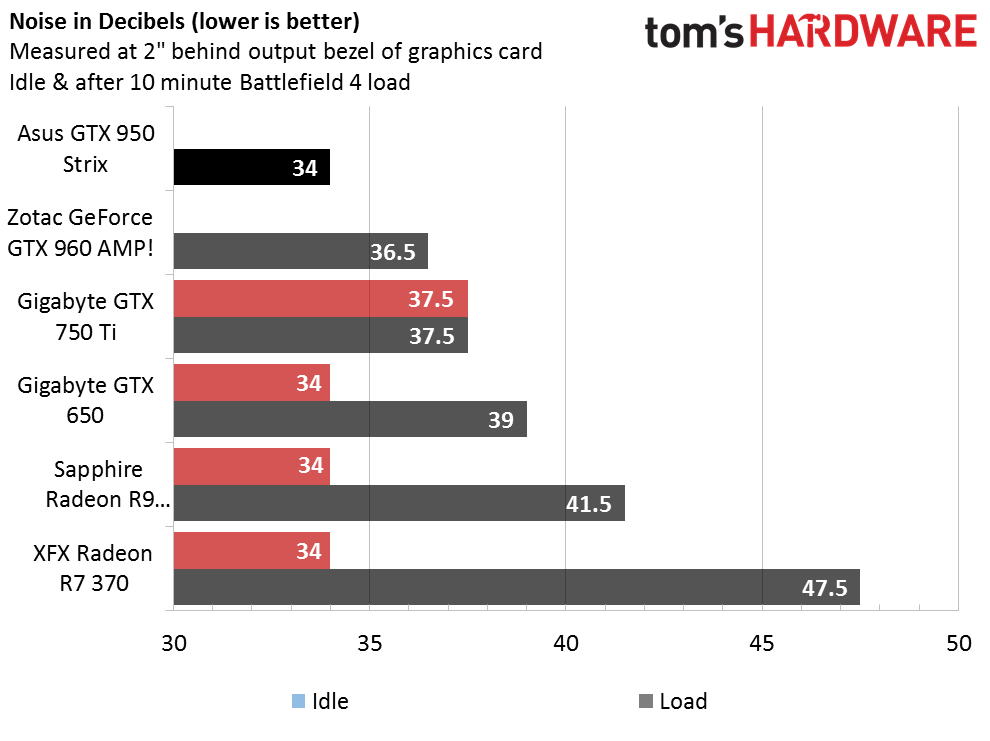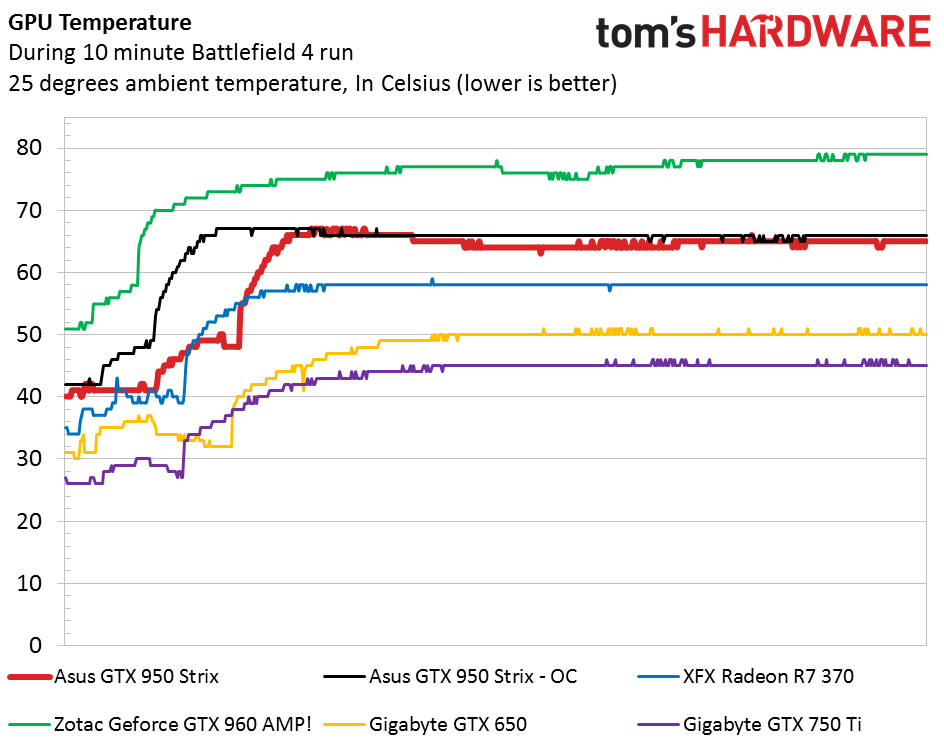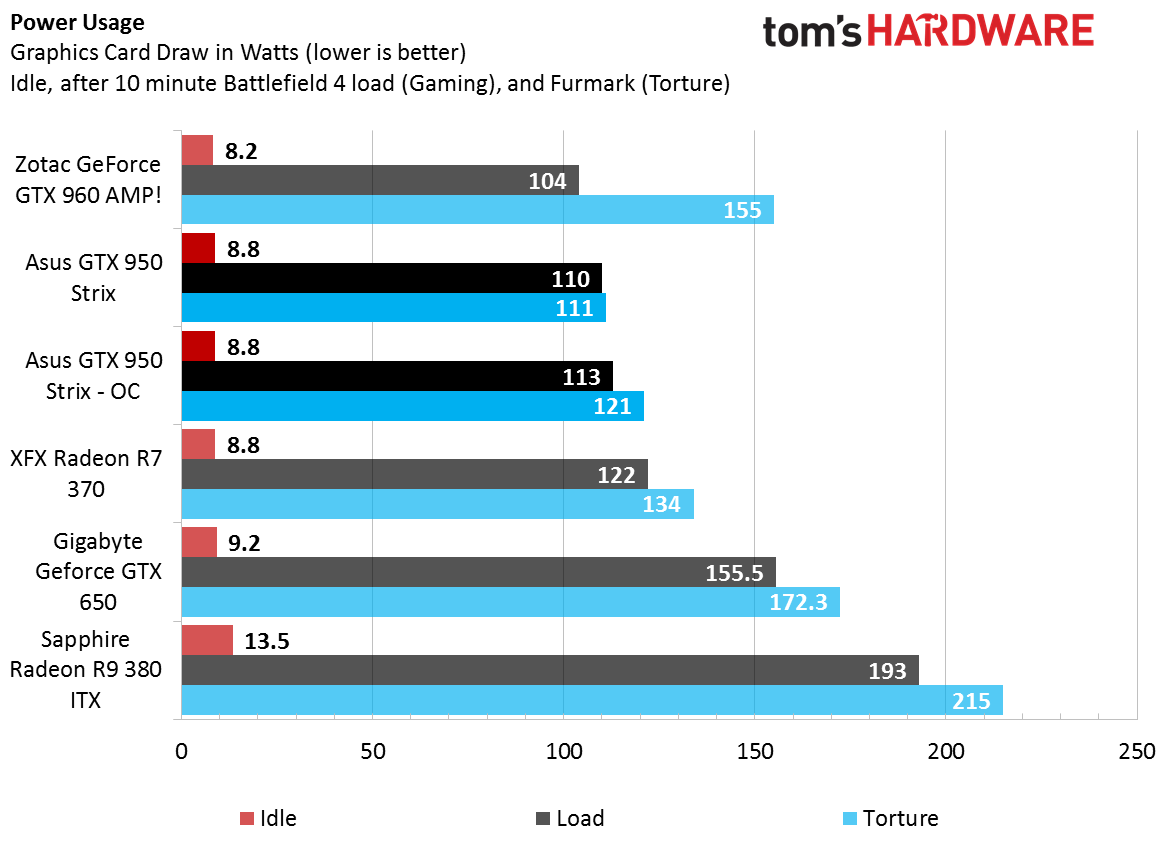Asus GeForce GTX 950 Strix Review
Today we get our first look at Nvidia's latest GPU in Asus' GeForce GTX 950 Strix.
Why you can trust Tom's Hardware
Audio, Thermal And Power Testing
Noise
Asus equips its GTX 950 Strix with pair of 80mm fans, so this card was never going to be loud. We’ve tested these fans before and found them to be nearly silent, and the DirectCU II cooler has proven itself to be a robust and capable heat sink. With the ability to have the fans spin down under GPU temperatures of 60 degrees, Maxwell-based cards are often completely silent at idle.
Asus’ GeForce GTX 950 Strix is no exception. In fact, it ended up being one of the quietest graphics cards I’ve tested. Since my equipment doesn’t read below 35 dB(A), and I could make out some noise in a silent room, I listed it as 34 dB(A) under load. It may be slightly quieter than this in reality. The only other card that was too quiet for my equipment was the MSI GTX 960 I tested back in May.
At idle, the fans don't move. The temperature sits around 40 degrees in this semi-passive mode.
Temperature
Having worked with several different iterations of the Maxwell architecture, as well as a number of different DirectCU coolers from Asus, I had a pretty good feeling I would see excellent cooling performance from this card. Even with just two heat pipes and a much smaller fin array, I expected Maxwell's efficiency to shine.
In testing, the card never exceeded 67 degrees, even after overclocking. As you can see from the graph, the temperature ramped up quite a bit quicker with the GPU overclocked, but it settled back down at just two to three degrees warmer than the stock speeds under load.
There are two interesting observations here. First, the Radeon R7 370, which draws quite a bit more power, actually runs cooler than Asus' GTX 950 Strix. AMD cards have a reputation for running hot, so this caught my eye. Of course, I'm sure the outcome has a lot to do with fan speed, which is made apparent in our noise test. The other stand-out was how cool the GeForce GTX 650 runs. It's nowhere near as powerful, but you can see that it doesn’t generate anywhere near the same levels of heat either.
Power Usage
Nvidia’s Maxwell architecture is renowned for its efficiency. The company has made some incredible progress in improving performance per watt. Pair that with the value nature of the GTX 950, and it was pretty safe to assume that this card's consumption would be fairly low.
Get Tom's Hardware's best news and in-depth reviews, straight to your inbox.
That assumption proved correct. Surprisingly, Zotac’s GTX 960 AMP idles slightly under the GTX 950 Strix, though just over half of one watt is negligible. The load power test was again surprising, as the GTX 960 managed to draw 6W less in Battelfield 4. Comparing Asus’ GTX 950 Strix to the Gigabyte GTX 650 tells a much better story. The older/slower GPU's power requirements are significantly higher than the new GTX 950, drawing as much as 45W more under load.
AMD’s R7 370 matches the idle power draw of the GTX 950, but Nvidia’s GPU is quite a bit more efficient when we tax it.
Kevin Carbotte is a contributing writer for Tom's Hardware who primarily covers VR and AR hardware. He has been writing for us for more than four years.
-
g-unit1111 So how does this compare in price to the GTX 960? If it's lower by about $20 - $30 I would think this card would be selling like hot cakes.Reply -
Math Geek very interesting looking card. nvidia has been doing a lot of this lately offering almost the same performance for less money than a pretty new card. it indeed looks like an awesome budget card well above the 750ti and almost as good as the 960 for a lot less.Reply
will be very interested in the other versions of this that show up. nvidia trumps amd yet again. *sigh* when will the carnage end?? please amd do something to stay relevant!!! -
Math Geek ReplySo how does this compare in price to the GTX 960? If it's lower by about $20 - $30 I would think this card would be selling like hot cakes.
article says about $160 so more like $40 less than the amp edition they compared it to. however, with prices at $175 or so on the low end it is closer to an average of $20 or so price drop. which is why he states the 960 should lose the recommendation to this card since it is almost the same performance for a less. if your goal is 1080p at decent frames according to this review there is little reason to spend the extra money on the 960 over the 950. if course this is only price speculation. once they are out, the price will drop more than likely making this even more of a good deal. -
InvalidError This might be the final nail in most of AMD's rebadged products coffins. If my HD5770 decided to die on me in the near future, I would seriously consider the GTX950.Reply -
Math Geek on the high end amd still looks ok with the new stuff but the mid to low end they are clearly not taking the nod at any price point. next gpu chart will probably be all nvidia until the very end when it might dual suggest the 390 with the 970........ maybe......Reply -
Onus I noticed some inconsistencies in the charts; sometimes the GTX750Ti is there, sometimes it isn't. To me, this is the card the GTX950 replaces, although I am disappointed it needs a 6-pin power connector.Reply
The card does look like a winner though, and reinforces a lesson I've ignored to the detriment of my wallet more than once; for a single monitor, $150-$175 is all that needs to be spent on a graphics card in order to get good settings for games.
I have to agree with the sentiment that AMD better get its tail in gear if they want to remain relevant.
-
kcarbotte ReplyI noticed some inconsistencies in the charts; sometimes the GTX750Ti is there, sometimes it isn't. To me, this is the card the GTX950 replaces, although I am disappointed it needs a 6-pin power connector.
The card does look like a winner though, and reinforces a lesson I've ignored to the detriment of my wallet more than once; for a single monitor, $150-$175 is all that needs to be spent on a graphics card in order to get good settings for games.
I have to agree with the sentiment that AMD better get its tail in gear if they want to remain relevant.
I went through the charts. Looks like the only one missing 750ti is Metro at 1080p. I've requested the image be amended. FYI: min 30, avg 39.625, max 54 on the 750ti.
Nvidia has moved the 750ti to the lower price point, but keeping it on the market.
The 950 isn't being positioned by Nvidia as an upgrade from the 750ti, as the performance isn't a big enough jump for most consumers to make the change.
It is however a notable improvement in performance over a 750ti. -
kcarbotte ReplySo how does this compare in price to the GTX 960? If it's lower by about $20 - $30 I would think this card would be selling like hot cakes.
article says about $160 so more like $40 less than the amp edition they compared it to. however, with prices at $175 or so on the low end it is closer to an average of $20 or so price drop. which is why he states the 960 should lose the recommendation to this card since it is almost the same performance for a less. if your goal is 1080p at decent frames according to this review there is little reason to spend the extra money on the 960 over the 950. if course this is only price speculation. once they are out, the price will drop more than likely making this even more of a good deal.
Bingo.
There's very little reason to get a GTX 960 over a 950 at this point in my view. The extra money, albeit only $40 or so, would be better served in a different component, or on a game.
-
logainofhades Reply16493184 said:I noticed some inconsistencies in the charts; sometimes the GTX750Ti is there, sometimes it isn't. To me, this is the card the GTX950 replaces, although I am disappointed it needs a 6-pin power connector.
The card does look like a winner though, and reinforces a lesson I've ignored to the detriment of my wallet more than once; for a single monitor, $150-$175 is all that needs to be spent on a graphics card in order to get good settings for games.
I have to agree with the sentiment that AMD better get its tail in gear if they want to remain relevant.
Maybe that card will be a 940?


